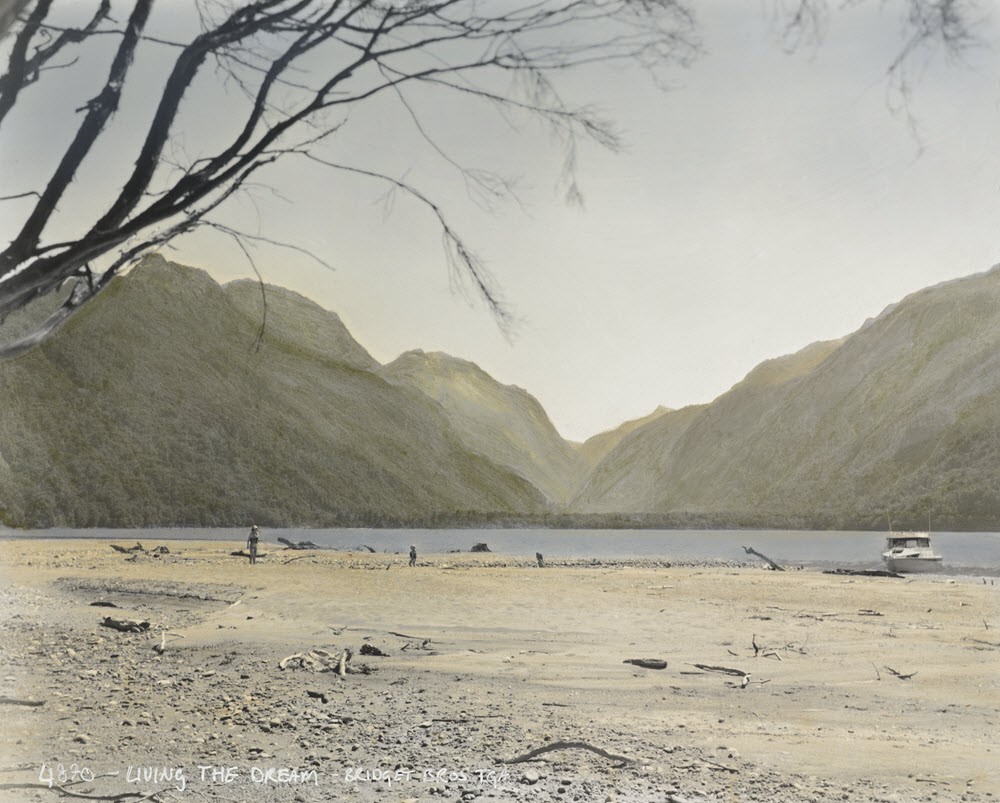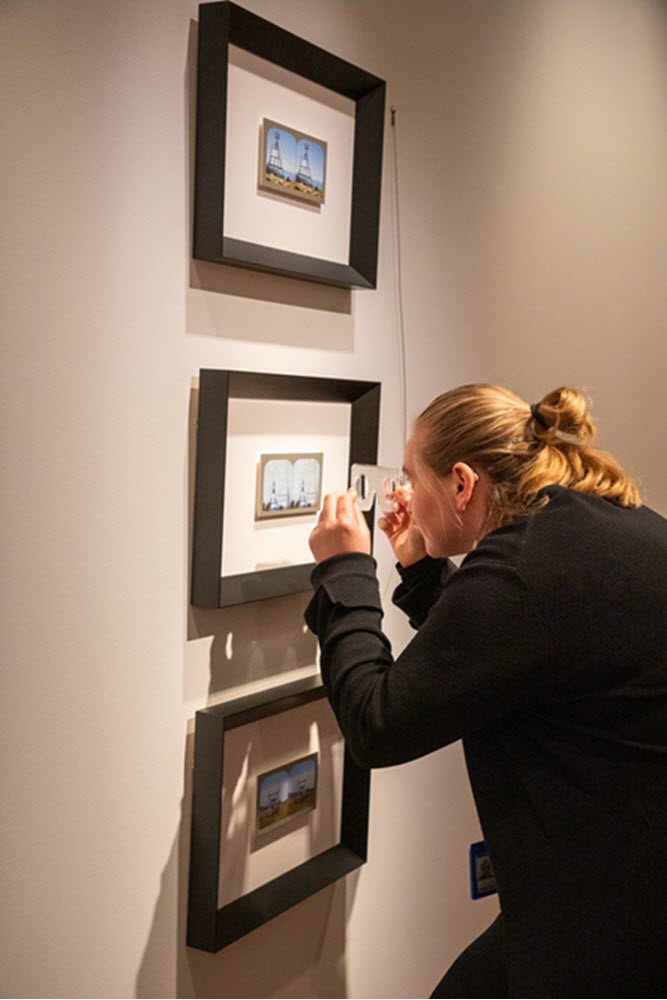Post cooked up by Eilish McHugh-Smith, Collections Assistant – Publications
Our recent return to Covid alert level 4 prompted Hocken Staff to fish through their camera rolls and personal bookshelves in search of historical culinary delights to tantalise their bubble’s taste buds. In the preceding weeks, I had been on a mission to find a selection of the most peculiar and delicious sounding recipes within our cookbook collection, so had an array of delights to choose from.
One of my favourite finds is a well-loved copy of New Zealand women’s household guide: containing recipes and general hints, dating from 1934 or 1935.[1] This was published by the Women’s Division of the New Zealand Farmers’ Union, an organisation established in 1925 by the wives of members of the Farmers’ Union to help combat the isolating nature of farm life, advocate for the needs of rural women and children, and of course, provide support to the Farmers’ Union.[2] As part of this the Women’s Division also emphasised and advocated for enhanced home science education, which appears to have been a motivating factor behind this book and its other iterations, some of which the Hocken is fortunate to hold.[3]
Notable recipes within the 1934/1935 edition include milk soup (containing a mere 5 ingredients: milk, onions, vermicelli, salt and pepper), mock whitebait (potato flavoured with anchovy sauce), stewed lettuce, a Marmite omelette, gingerbread cookies and currant buns.[4] However, with week one of lockdown over my bubble was craving comfort food. This led me to the recipes for macaroni soup and ginger pudding, akin to modern day macaroni cheese and a ginger cake- surely these would satisfy.

The macaroni soup recipe [New Zealand women’s household guide: containing recipes and general hints] ([Wellington]: Women’s Division of the New Zealand Farmers’ Union (Inc.), [1934-1935?]), p.12.

The ginger pudding recipe [New Zealand women’s household guide: containing recipes and general hints] ([Wellington]: Women’s Division of the New Zealand Farmers’ Union (Inc.), [1934-1935?]), p.187.
First up was the batter of the Ginger Pudding:
Ginger Pudding
Ingredients
- 3 eggs
- 1 cup sugar
- ½ cup (115 grams) of butter or dripping
- 3 cups of flour
- 1 tablespoon of ginger
- 1 cup milk
- 1 teaspoon soda
- 2 teaspoons of cream of tartar
Method
- Mix all ingredients together
- Bake in a flat dish for ¾ of an hour [Assumed a similar temperature to most cakes (160 degrees Celsius in a fan bake oven)]
- Original recipe included the note: “What is left from dinner makes a nice plain cake for afternoon tea if a little chocolate icing is put on top”
Interestingly, the resulting mixture was more akin to dough than a typical modern-day cake batter, as the mix was so dry, I struggled properly combine the flour. I also decided to use a large cake pan rather than a small flat dish, out of fear of the mess an overflow would make. Upon baking I found this meant the pudding was still liquid in the centre after 45 minutes and required a further 20 minutes to cook fully. However, as the cake doubled in size, I was relieved to have made the right dish decision.
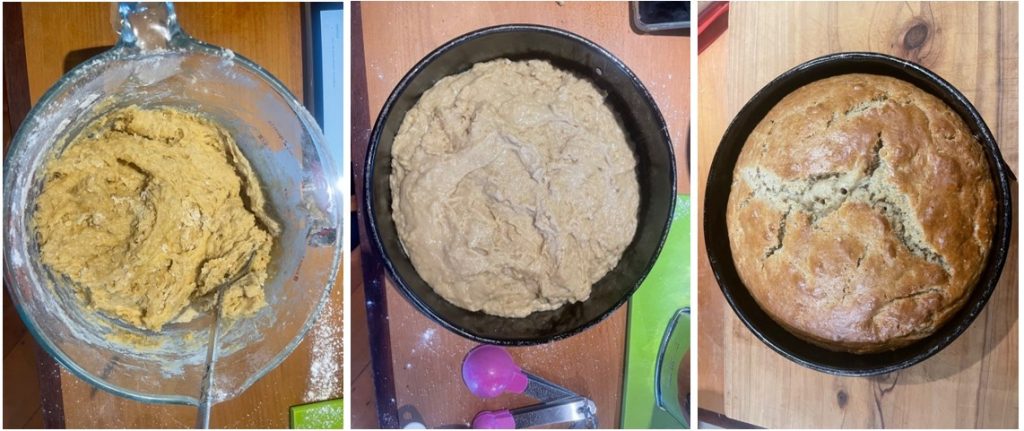
The batter as it was combined, the batter in the tin, and the final product.
Meanwhile, preparations for the soup began:
Macaroni soup
Ingredients:
- 1 pound (454 grams) broken up macaroni [I used spiral pasta as macaroni was out of stock]
- Salted water [I assumed this would be enough to cover the macaroni by about a couple of centimetres]
- Sufficient stock [I used about 2 cups of chicken stock]
- ½ pint (284 millilitres) of milk or cream [I assumed that this was referring to an imperial pint]
- 5oz (142 grams) grated cheese
Method
- Break up macaroni and boil in salted water until tender
- Remove half the macaroni from the pot and hold aside
- Continue boiling the remainder in to pot until it turns to pulp
- Add stock, milk or cream, cheese and return the held-aside macaroni to the pot
- Warm without boiling and serve with toast
This was relatively smooth sailing, aside from the requirement to boil half the pasta to a pulp. With an image of wallpaper paste like gloop in my head I set about boiling it for an hour and a half, by which point the pasta remained relatively intact but swollen. With stomachs growling and one bubble member telling me it “looks pulpy to me”, I made the decision to carry on with the remaining steps.

The ‘pulpy’ pasta after one and a half hours of boiling.
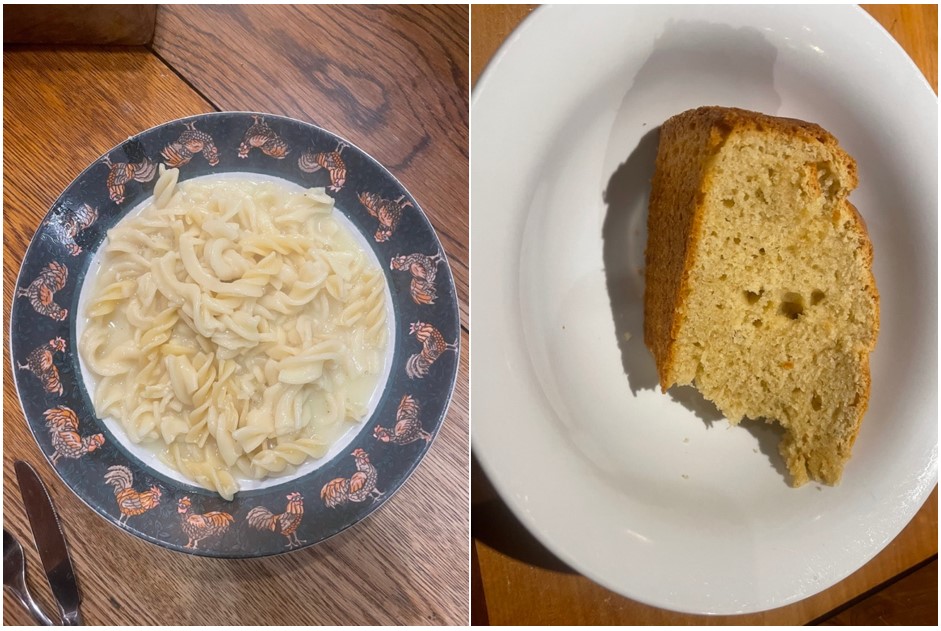
All plated up: the final products
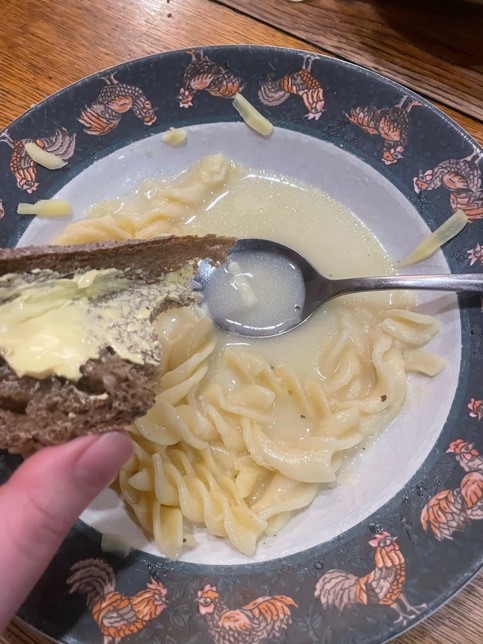
A close-up to show the soup’s true soupiness.
First up for the taste test was the Macaroni Soup, which received comments such as: “rather flavourless”, “kind of like those quick pasta packet things” and “this is just pasta in salty water”. It was awarded an average rating of 2.5/10 from our bubble, with the consensus being that the wateriness was its biggest shortfall. Personally, I found its indescribable texture a bit challenging and could not find a discernible flavour to it. However, everyone finished their bowl, so it was certainly edible.
In contrast, the Ginger Pudding received slightly more favourable comments like “would be nice with custard”, “better than dinner” and “a lot like steam pudding”. However, its dry stodginess and a desire for a stronger ginger flavour were certainly noted. Overall, it received an average rating of 5/10, but 24 hours later remained untouched on the kitchen bench. Interestingly, the remaining pasta was snaffled before I ate lunch the following day, but I suspect some extra goodies were added to boost its flavour.
Overall, the meal was edible and filling, with the bonuses of being budget friendly and simple to prepare. These would likely have been key considerations for the Women’s Division in their mission to advance home science education for rural women. However, macaroni would likely have been more expensive than today, as it was not until 1941 that The Timaru Milling Company became the first company in New Zealand licensed to produce pasta under the brand name “Diamond” and not until the 1970s and 1980s that pasta became common place on New Zealand dinner tables.[5] Nevertheless, today pasta in all its forms holds a dear place as a staple comfort food in the hearts of many Kiwis, including my bubble’s.
[1] [New Zealand women’s household guide: containing recipes and general hints] ([Wellington]: Women’s Division of the New Zealand Farmers’ Union (Inc.), [1934-1935?]).
[2] Rosemarie Smith, ‘Rural Women New Zealand’, New Zealand History, www.nzhistory.govt.nz; accessed 24 August 2021.
[3] Rosemarie Smith, ‘Rural Women New Zealand’, New Zealand History, www.nzhistory.govt.nz; accessed 24 August 2021.
[4] [New Zealand women’s household guide: containing recipes and general hints] ([Wellington]: Women’s Division of the New Zealand Farmers’ Union (Inc.), [1934-1935?]), pp. 6,17,93,103,232.
[5] Sarah Wilcox, ‘Story: Food and beverage manufacturing – Changing technology and tastes’, Te Ara – the Encyclopaedia of New Zealand; www.teara.govt.nz; accessed 27 August 2021; ‘About us’, Diamond, www.diamondmeals.co.nz; accessed 26 August 2021.
References
‘About us’, Diamond, www.diamondmeals.co.nz; accessed 26 August 2021.
[New Zealand women’s household guide: containing recipes and general hints] ([Wellington]: Women’s Division of the New Zealand Farmers’ Union (Inc.), [1934-1935?]).
Smith, Rosemarie, ‘Rural Women New Zealand’, New Zealand History, www.nzhistory.govt.nz; accessed 24 August 2021.
Wilcox, Sarah, ‘Story: Food and beverage manufacturing – Changing technology and tastes’, Te Ara – the Encyclopaedia of New Zealand; www.teara.govt.nz; accessed 27 August 2021.
What else have we cooked up?
Stirring up the stacks #8: Xmas Cake Recipe Recommended by “Buckhams”
Stirring up the stacks #7: Virginia pudding
Stirring up the stacks #6: Pumpkin pie
Stirring up the stacks #5: Sauerkraut roll
Stirring up the stacks #4: A “delicious cake from better times”
Stirring up the stacks #3: Bycroft party starters







